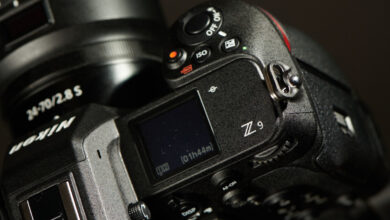Sigma’s latest masterpiece: We review the 24-70mm f/2.8 DG DN II art lens

Sigma’s latest Art series lens, the 24-70mm F2.8 DG DN II, takes the superior formula of its predecessor and takes it to the next level, delivering significant improvements in sharpness. , autofocus speed and overall handling capabilities. The lens isn’t content with just meeting the high expectations set by the original lens; it surpasses them, delivering outstanding image quality that will impress even the most demanding photographers.
This lens handles everything from studio photography to landscapes and then some, making it a serious contender in the market. Does it live up to the hype? We review it to find out!
 Quality construction
Quality construction
According to the press release, the Sigma 24-70mm f2.8 DG DN II Art lens takes advantage of the latest technologies and is approximately 7% smaller and 10% lighter than the previous version, weighing only 745 grams.
The lens feels sturdy and is dust and water resistant, allowing you to feel safer in more challenging weather conditions. There’s also a water- and oil-repellent coating on the front for an added layer of protection.
The lens now has an additional aperture ring that can reduce clicking, which can be useful for filmmakers to make smooth adjustments during shooting. There is also a lock switch for the aperture ring to prevent accidental changes. Other buttons on the lens body include two autofocus lock buttons that can be assigned via menu depending on the camera model. One is placed above the lens and the other on the side. The MF/AF button and zoom lock button lock the lens at 24mm to prevent any barrel drift due to its weight. I only lock this when transporting the camera, but when in use, I’ve never noticed the lens accidentally extending. Perhaps they are looking to the future as this can sometimes happen with lenses.
The zoom and focus rings are well designed and feel good. Friction is smooth and has enough resistance for precise manual focusing. It’s worth mentioning that the focus ring rotates infinitely, which I found very useful in some situations.
The lens hood features a sturdy plastic petal-shaped design that attaches and locks into place with a clear click. The filter thread size of 82mm probably means you don’t have to buy any additional increasing/reducing rings if you already have filters of that size.
Main specifications
- Lens construction: 19 elements in 15 groups (6 FLD elements, 2 SLD elements, 5 aspherical elements)
- Viewing angle: 84.1-34.3°
- Number of membrane leaves: 11 (round membrane)
- Minimum aperture: F22
- Minimum focusing distance: 17 cm (W)-34 cm (W)
- Maximum magnification ratio: 1:2.7 (W)-1:4 (T)
- Filter size: 82mm
- Dimensions (maximum diameter x length): 87.8mm x 120.2mm
- Weight: 745 grams
Efficiency
I found the optical performance of this lens to be outstanding so I pre-ordered one. This is now the second Sigma lens I have purchased so soon after my test drive due to the image quality. The image quality it produces in terms of sharpness and clarity right across the frame is what I would expect from a much more expensive lens. This lens consists of 19 elements in 15 groups, including 6 FLD (F Low Dispersion) glass elements, 2 SLD (Special Low Dispersion) glass elements, and 5 aspherical elements. This optical configuration helps minimize aberrations and various color fringing, and performs very well throughout the entire zoom range.

It’s ideal for capturing detailed close-up shots with a minimum focus distance of 17cm at 24mm. The f2.8 constant aperture ensures outstanding performance in low-light conditions and allows for beautiful bokeh and background separation.
Thanks to Sigma’s HLA (High Response Linear Actuator) motor, autofocus is fast, quiet and precise, and in my time with the lens it never missed once. I also used it for some video work and again had no problems. Combined with Sony’s eye tracking feature in the Sony a7R V, it worked perfectly for me.
I mainly took a lot of architectural photos with this lens to see how it performed across the frame in terms of sharpness with different angles of the buildings. Capturing the intricate details of different architecture allowed me to evaluate the sharpness and control of distortion of the lens. Distortion is minimal and easily corrected in post. However, for the images shown here, I made no edits so you can judge for yourself. Sharpness across the frame, even at 24mm, is sharp, which I would expect from a much more expensive lens. This lens handles high-contrast scenes extremely well, delivering rich detail and minimal chromatic aberration, even offering a sun star at f/7.1.

In addition to architectural photos, I also took this lens into the woods to see how it handled more natural shapes. Even though there was still a lot of light in the early morning, this lens’s ability to capture fine details in the forest, from the texture of tree bark to the canopy overhead, was impressive.

I’m not looking for bugs or problems with the lens; I’m looking to see how it will perform in the environments I usually photograph. As I mentioned before, I pre-ordered one because it performed very well for me in these environments, providing everything I required in terms of sharpness and detail.
Advantage
- Sharpness
- Weight
- Additional aperture ring
- Price
Defect
I think Sigma has got everything here that you need in a mid-range zoom lens in terms of sharpness, functionality, and value. There isn’t anything I can see that might be considered; it’s a great lens.
Conclusion
The 24-70mm lens is often a staple in any photographer’s kit bag, and thanks to its compact design, it’s relatively compact at 120mm and highly portable. It’s ideal for many genres of photography, which, you guessed it, includes everything from wide angle to mid-range.
Simply put, this lens is excellent. This lens is available for Sony and Leica mounts and in my opinion is a very worthwhile investment if you are in the market for a mid-range focal length. The images returned were always sharp and clear, and in some cases I actually reduced image clarity to achieve the results I was looking for. During my time with this lens, I did not program the buttons for any functions through the menu, and I probably never will when I have my own functions. However, with both available, anything is possible.
May 30 is the release date Sigma 24-70mm f/2.8 DG DN II art lens, is available for pre-order now. If you’re looking to buy a mid-range telephoto lens and haven’t bought one yet, I would definitely check this one out.




